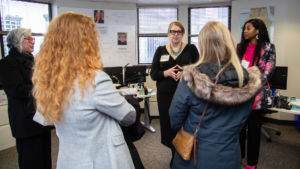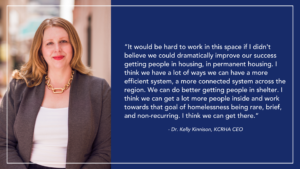This is the written testimony of CEO Marc Dones, submitted to the Congressional Record, for a hearing before the U.S. House Financial Services Subcommittee on Housing, Community Development, and Insurance.
Introduction
Thank you to the Chair and the rest of the Subcommittee for the opportunity to come and speak today. This could not come at a timelier moment in our nation’s steps towards recovery from the crises of the last two years. My name is Marc Dones and I have the honor of serving as the Chief Executive Officer of the King County Regional Homelessness Authority. Created via legislation in 2019, the Authority is charged with oversight of the entirety of the homelessness system in King County (inclusive of the city of Seattle, the additional 38 cities in the county, and our unincorporated areas). Prior to launching the Authority in 2021, I had the pleasure of serving in various leadership positions across the human services sector, including work in gang violence prevention, substance use disorder treatment, and child welfare system reform, in addition to my work in housing and homelessness.
Overview
In order to solve homelessness, we must accurately understand what we are currently facing: a growing crisis of national proportions aided and abetted by policy choices that have misunderstood the root causes of homelessness and under-resourced the solutions that are most effective. Our investments in the homelessness space have been overfocused on service systems that offer sub-clinical support while leaving systems and providers unable to provide the actual housing solutions that people need.((What Housing First Really Means, National Alliance to End Homelessness, March 18, 2019, https://endhomelessness.org/what-housing-first-really-means/))
As the system administrator for the third largest Continuum of Care in the country,((The annual homeless assessment report to Congress, U.S. Dept. of Housing and Urban Development, Office of Community Planning and Development. https://www.huduser.gov/portal/sites/default/files/pdf/2020-AHAR-Part-1.pdf)) I feel obligated to carry the banner of the hundreds of provider agencies and the tens of thousands of people who do this good work every day. And so, I’m here to tell you that it simply doesn’t matter how many social workers attend to a person’s needs, how many outreach workers are available to connect with our unsheltered neighbors, if we don’t have anywhere for them to go. And that is precisely where we stand today. The fundamental reality is that there is no number of social workers who will ever transform into a house. Until we prioritize stabilizing the housing market for lower income individuals, we will not end homelessness—we will simply manage it. And that is an unacceptable policy solution.
We must also recognize that homelessness is incontrovertibly a racial justice issue and an issue of justice broadly. Homelessness disproportionately impacts people of color as a direct result of this country’s history of racialized exclusion from housing. While Black people represent only 12% of the general population, we routinely make up 30 – 40% (or more) of the homelessness population. Native people, who make up only 1% of the general population, often make up 3 – 6% of the population experiencing homelessness.((id))
We must not forget that it wasn’t until 1968 with the passage of the Fair Housing Act that this country stepped towards ensuring that people of color, and particularly Black and Native people, had access to the same housing finance tools as white Americans.((The Color of Law: A forgotten history of how government segregated America, Richard Rothstein, 2018, p.48-60)) This legacy is alive today in the patterns of generational wealth that communities do or do not have access to in order to get through hard times like housing bubble bursts and global recessions.((The Recession Was Much Worse for Black Americans, Gillian B. White, The Atlantic. June 24, 2015, https://www.theatlantic.com/business/archive/2015/06/black-recession-housing-race/396725/)) Or global pandemics.
Our national strategy to end homelessness must be aligned with these fundamental realities and focused on ending the racist and racialized outcomes that continue to harm people, even as we sit here today. Put quite frankly, the time has come for America to decide whether it will live down to its racist history or live up to the dreams we all hold for it. And the decision to solve homelessness (or not) is a core component of that decision.
I’m hopeful that the decision we will make collectively is one that will continue to move us down the path of progress; progress that allows me to sit here speaking with you as a queer Black person who is grateful to spend their life attempting to make government work for all of us. A person who is grateful to discuss some of the important needs my community has, and indeed all of our communities have, if we are to be successful in moving forward.
Acquisitions & Direct Benefits
First and foremost, we must understand that homelessness is an economic issue. It’s about not having the money to pay the rent. At the local level, we see over and over again that many of the people in our shelter system, or frankly in our encampments, are working.((Shier, Micheal L., Marion E. Jones, and John R. Graham. “Employment Difficulties Experienced by Employed Homeless People: Labor Market Factors That Contribute to and Maintain Homelessness.” Journal of Poverty 16, no. 1 (2012): 27–47. https://doi.org/10.1080/10875549.2012.640522)) What they aren’t making is a living wage to acquire housing.((Out of Reach, https://nlihc.org/sites/default/files/oor/2021/Out-of-Reach_2021.pdf)) And we should be clear this is not simply an issue in our dense urban areas. King County is one of the largest counties in the country, and whether you’re attempting to live in Seattle or in one of more rural communities, the cost of living is increasingly out of reach.((US Census, “More than Half of U.S. Population in 4.6 Percent of Counties.” Census.gov, October 8, 2021, https://www.census.gov/library/stories/2017/10/big-and-small-counties.html))
We also know that the belief that the majority of people experiencing homelessness have significant mental health or substance use concerns is false.((Didenko, Eugenia, and Nicole Pankratz. “Substance Use: Pathways to Homelessness? Or a Way of Adapting to Street Life?” http://www.heretohelp.bc.ca/visions/housing-and-homelessness-vol4/substance-usepathways-homelessness)) In my own research and the research of others, what we tend to see is that even if people present with these concerns, they frequently begin after the experience of homelessness, not before.((Addiction, Mental Health and Homelessness.((National Health Care for the Homeless Council, 2007, www.nhchc.org)) The reality is that every day we allow someone to experience homelessness, the harder it will be for us to connect them with the resources they need.((https://nhchc.org/wp-content/uploads/2019/08/homelessness-and-health.pdf))
Because of this, we must transform our homelessness systems into true crisis response systems, as has been repeatedly called for in previous USICH federal strategic plans, dating all the way back to the first Opening Doors plan in 2010. In order to do that we must equip systems with the necessary resources to act quickly and decisively when a person or family experiences homelessness. Particularly in the wake of COVID-19, systems need the resources to rapidly pivot and expand non-congregate options for people who experience homelessness. Jurisdictions across the country have seen success in rapidly acquiring and repurposing hotels, motels, and stalled market rate projects to repurpose as non-congregate shelter and housing supports for people experiencing homelessness. It is critical to double down on supporting communities to engage in this work now, to rapidly online housing and shelter options that can bring people inside without having to slog through the typical development timelines.((Covid-19 Homeless System Response: Unit Acquisition, https://www.usich.gov/resources/uploads/asset_library/COVID-19-Homeless-System-Response-Unit-Acquisition-Strategies-and-Exampl
es-to-Support-Housing-Development.pdf))
To some degree, this a reinvestment in the SRO and other low-income housing stock that was wiped from the American landscape during the suburbanization of the 50’s, 60’s, and 70’s. The loss of this low-income housing stock has played a significant role in the inability of Continuums of Care to exit people from homelessness without some form of subsidy, and in the rise of the modern formation of homelessness itself.((Burt, Martha R., Over the Edge: The Growth of Homelessness in the 1980s, Russell Sage Foundation, 1993))
As you’ll hear from some of my colleagues today, the increase in voucher availability could be a critical path to creating and maintaining this kind of housing infrastructure, and the specific capacity to use new vouchers at both the individual level and through project-based strategies will be critical in supporting communities with complex and expensive housing markets.((Will Fischer, Sonya Acosta, Erik Garland, Vouchers: More Housing Vouchers: Most Important Step to Help More People Afford Stable Homes, Center for Budget Policy and Priorities, 2021, https://www.cbpp.org/sites/default/files/4-14-21hous.pdf))
We should also be clear that the restoration of these kinds of housing options will not address some of the other underlying economic needs, particularly those that impact communities of color and other historically marginalized communities. Given the increasingly fragile economic networks these communities are facing, we must provide local jurisdictions with the resources, through diversion and other direct cash assistance, to stabilize communities and slow the flow into homelessness.((Bogle, Mary. “Why Cash Assistance Is Essential to Moving Americans out of Poverty.” Urban Institute, September 21, 2016, https://www.urban.org/urban-wire/why-cash-assistance-essential-moving-americans-out-poverty)) These kinds of programs have been demonstrated time and again to be effective uses of public resources, and prevent more expensive public investment further downstream.
Quality Data & Targeting Resources
It is also critical that our systems continue to drive towards quality data that is useful for real time decision making. Systems need federal support in taking the next steps in improving their HMIS data infrastructure and creating the culture of continuous quality improvement necessary to turn information into action. Approaches tailored in this way have shown broad efficacy in health and human services and public health programming for years.((Claudia Coulten, Robert Goerge, Grand Challenge: Harnessing Big Data for Social Good, 2015, https://grandchallengesforsocialwork.org/wp-content/uploads/2015/12/WP11-with-cover.pdf)) However, communities need more resourcing to drive their data work towards the sophistication we know is possible in 2022.
This data is critical for the appropriate targeting of resources, which absolutely must include the prioritization of people experiencing unsheltered homelessness. It is unacceptable for our policies to force people to live outside, and we must make a concerted effort to end unsheltered homelessness in America. The recent rise in unsheltered homelessness across the country should make it clear that when we don’t target our resources towards those who are experiencing unsheltered homelessness or at high risk of becoming unsheltered, the result is a growing population living outside whose needs become more complex by the day.((The annual homeless assessment report to Congress, ibid))
Investing in People
Finally, we must invest in our workforce. In King County we currently have sites identified for programs that could support people, but we’re unable to support staffing them. For 30 years, our field has been funded at levels that have not allowed us to keep up with wages in other sectors, and as a result we’ve seen our workforce pipeline collapse. System administrators from across the country are asking how we can maintain continuity of operations as providers hemorrhage staff who are no longer willing to tolerate making poverty wages for some of the most complicated work.
The fact of the matter is that this is a system that is delivered by people. This work is done by people helping people. There is no app or technological revolution that is going to change that. Housing case managers, recovery coaches, peer navigators—these are all fancy terms for people who have decided that the thing they want to do with their lives is support others. And we as a country, as a society, need to decide—do we care about our caetakers? Or not?
This too is a race and gender issue. The majority of our frontline staff across the country are women and women of color.((Brown, Hayley, Shawn Fremstad, and Hye Jin Rho, A Basic Demographic Profile of Workers in Frontline Industries, Center for Economic and Policy Research, 2020, https://cepr.net/a-basic-demographic-profile-of-workers-in-frontline-industries/)) It is no accident that while other human service fields have experienced wage growth ours has been stagnant.((Lawrence Mishel. Causes of Wage Stagnation, Economic Policy Institute, 2015, https://files.epi.org/2013/causes_of_wage_stagnation.pdf)) And candidly, without the people who do this work, no work will be done—we must prioritize our people in all budget actions at the federal, state, and local levels.


